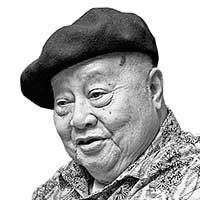Writing the land

Barrio Cabugawan is an Ilokano farming village where I grew up. My childhood playmates were farm boys. I learned how to plow a field as a boy. Plowing requires skill and a steady hand. If the plow is held at a high angle, the plowshare will bite deep into the soil and will break if the carabao does not stop. If the plow is held at a level angle, it will simply slide on the soil. I enjoyed racing the carabao and learned how to call a stray calf home.
Peasant food consists mostly of vegetables, shells and the fresh water fish from the flooded rice fields and streams. Then come the hungry months of the planting season – June to August – when farmer families eat only twice a day, 10 a.m. and 4 p.m., until September when the first harvest comes. Farm work is harsh, unremitting – my grandfather’s toes were splayed “like ginger” from constant immersion in the mud, and his hands were gnarled. Every farmer does not want his children to be like him. Sure, Amorsolo and Botong Francisco have romanticized peasant life. It is so ethereally beautiful; a field emerald green in the sunlight or golden with ripening grain, and the wonderful aroma of a newly harvested field – nothing equals it.
All these, however, belie the harshness of peasant life – the tenant farmer is burdened by debt from the landlord who can also drive him off the land at will. I was in grade one when the Tayug Colorum uprising erupted, but it resonated in Barrio Cabugawan. I was to meet Pedro Calosa, the leader of that uprising, later. He confirmed that the rebellion he mounted was his inevitable response to the oppression of the landlords in the region. But even before I met Pedro Calosa, I was already immersed in my study of our agrarian problem. I followed the Huk Rebellion that started immediately after World War II in response to the landlord oppression also in Central Luzon. This time, however, the Huks were better organized and armed. I sympathized with them. My novel, “My Brother, My Executioner,” is my literary commentary on that strife.
In the Visayan sugar haciendas, the peasants were also exploited, the wealth of the industry monopolized by the profligate sugar barons. I have been writing about it since the 1960s, identifying it as the single most obdurate obstacle to our economic and democratic development.
I went to Sulu to cover the earliest Moro rebellion, and then crossed over to Mindanao which was almost all jungle then. It was also land ownership that brought about Moro recalcitrance, not religion. To look for solutions to our land problem, I reviewed models abroad. I visited the kibbutz and the moshav in Israel, and an ejido in Morelos in Mexico, patterned after the old ejidos in Spain. I also saw the showpiece Chinese commune in Tachai.
When president Marcos declared martial law in 1972, he abolished tenancy in the rice and corn lands, replaced it with leasehold. This was perhaps the highlight of his regime; not even a purposeful Magsaysay could push such reform through a Congress dominated by landlords.
I even visited the Land Reclamation Institute in Wageningen, Holland to see how the Dutch reclaimed land from the sea. After the sea water is drained from the expanses created by high walls, they let the land lay fallow for five years before they planted on it. The kibbutz in Israel is the most radical agrarian experiment. Members live in a well-ordered community, their children in separate quarters. The kibbutz has also changed – some have gone industrial. The Chinese communes and Mexico’s ejidos have been disbanded. They were not productive enough. China forcibly transformed agricultural lands into industrial sites and housing development. It could easily do this; the state owns all the land. In India in the 1960s, Vinoba Bhave walked vast distances, asking the wealthy zamindars to donate land to the poor. Some did.
It was in Japan and Taiwan where land reform has had tremendous successes. MacArthur’s decree on agrarian reform is the single most important development in Japan after World War II as it truly democratized that country and gave social mobility to the lower classes. Taiwan today is also a shining example of how land can be made to yield more with the application of the new technologies. Taiwan has a lot to teach us.
This pandemic has forced us to look seriously at our food supply and realize the potential our land. Arable land in Japan is only 30 percent. Ours is double. There will be global hunger, perhaps famine.
As a writer, I’ve embraced this land as Mother Earth, to be cared for and to be loved as one loves his mother. I like to think that I belong to that small group of writers called agrarian novelists – Willa Cather, John Steinbeck and William Faulkner in the United States, and Leo Tolstoy, Pasternak and Gorky in Russia. And here, Manuel Arguilla, NVM Gonzalez and Stevan Javellana.
I would like to think, too, that all my novels celebrate this land, particularly “Tree.” “Sherds,” which is my last novel, repeats the theme of “My Brother, My Executioner” which is elegiac; some of my readers consider it my very best. I have tried to portray how the land shapes people, their character. I’ve said before that the farmer is the truest nationalist because he knows that it is the land which sustains him.
In saying this, I am reminded of my grandfather who was in the revolution of 1896. Hundreds of farmers like himself were all barefoot. And so, it is the same today with our Armed Forces – the enlisted men and officers come from our very poor.
In digging deep into native soil, I found the diamond core of these farmers-turned-soldiers. While I write the land with chiseled words, they wrote the land with their blood.
- Latest
- Trending
























